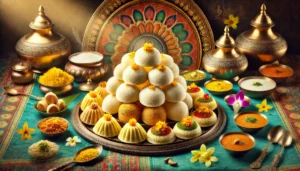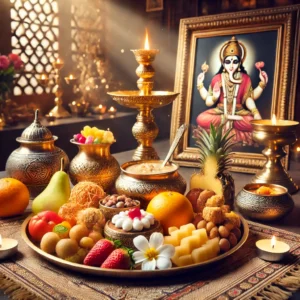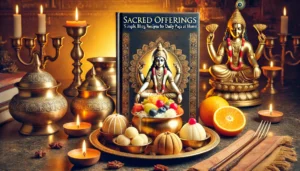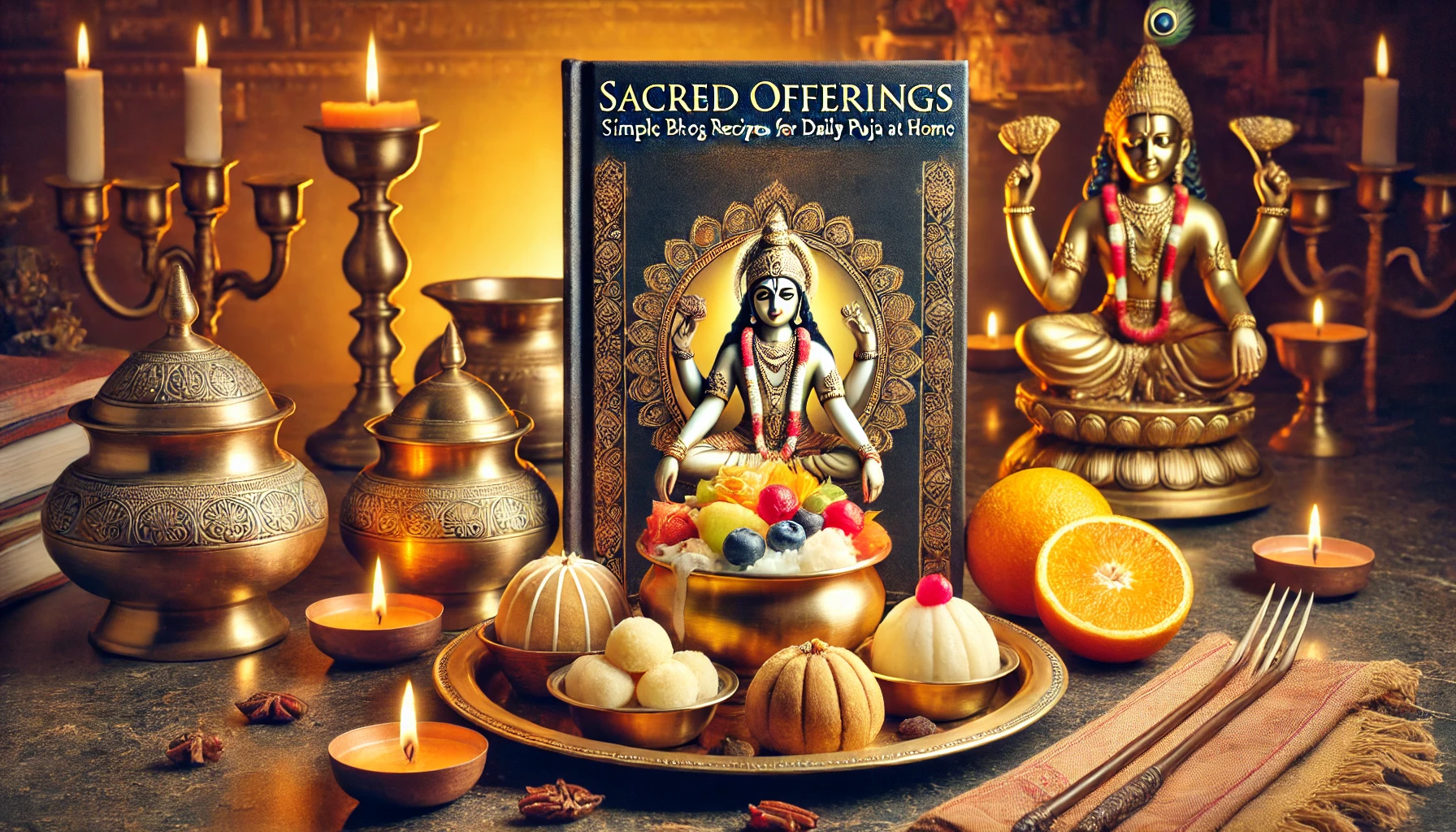
How to prepare bhog for daily puja at home
Offering Bhog at Home: Recipes for Daily Puja Meals
In Hindu tradition, bhog (sacred food) is offered to deities as an expression of love, devotion, and gratitude. Preparing bhog at home for daily puja (worship) is believed to bring peace, purity, and divine blessings. This sacred practice follows strict sattvic dietary guidelines—free from onion, garlic, and certain spices—to maintain spiritual sanctity.
Bhog varies from simple preparations like Panchamrit to elaborate feasts during festivals. In this article, we share traditional yet simple recipes that can be prepared as daily offerings to different deities.
Significance of Bhog in Hindu Worship
Bhog is not just food; it is an act of devotion, symbolizing surrender to the divine. The process of offering bhog follows a ritual:
Preparation with Purity – Food must be cooked with devotion, in a clean and peaceful environment.
Offering with Bhakti (Devotion) – Before consuming, the food is first placed before the deity, often accompanied by prayers or mantras.
Receiving as Prasad – After being offered, bhog becomes prasad, which is then shared among devotees as a divine blessing.
Each deity has specific preferences:
Lord Vishnu and Krishna – Love milk-based sweets like kheer and butter-based dishes.
Goddess Durga and Lakshmi – Prefer kheer, puris, and coconut-based sweets.
Lord Ganesha – Loves modaks, puran poli, and ladoos.
Lord Shiva – Is often offered bael leaves, raw milk, and fruits.
Table of Contents

How to prepare bhog for daily puja at home
Simple and Traditional Bhog Recipes
- Panchamrit (Sacred Nectar)
Panchamrit is a sacred mixture of five ingredients and is used for abhishek (ritual bathing of deities) and later distributed as prasad.
Ingredients:
2 tbsp milk
1 tbsp yogurt
1 tsp honey
1 tsp ghee
1 tsp sugar
Method:
Mix all ingredients in a clean bowl.
Stir well until combined.
Offer to the deity before consuming.
- Sooji Halwa (Semolina Pudding)
A beloved bhog for Hanumanji and Durga Maa, this easy-to-make sweet dish is rich in ghee and devotion.
Ingredients:
1/2 cup sooji (semolina)
1/4 cup ghee
1/2 cup sugar
1.5 cups water
2 tbsp chopped nuts (almonds, cashews)
1/4 tsp cardamom powder
Method:
Heat ghee in a pan and roast semolina on low flame until golden brown.
In another pan, heat water and sugar until fully dissolved.
Gradually pour the sugar water into the roasted semolina, stirring continuously.
Cook until the mixture thickens.
Add cardamom powder and nuts, mix well, and offer as bhog.
- Kheer (Rice Pudding)
A traditional bhog offered to Lord Vishnu, Krishna, and Lakshmi, kheer is a divine and comforting dish.
Ingredients:
1/2 cup rice
4 cups milk
1/2 cup sugar
1/4 tsp cardamom powder
2 tbsp chopped nuts (almonds, pistachios, cashews)
1 tsp ghee
Method:
Wash and soak the rice for 15-20 minutes.
Heat ghee in a pan and lightly sauté the rice.
Add milk and cook on low flame, stirring occasionally until the rice is soft.
Add sugar, cardamom powder, and nuts. Stir well.
Once thickened, offer the kheer to the deity before consuming.
- Makhana Prasad (Foxnut Offering)
A light and crunchy snack, makhana is a favorite of Lord Krishna and Devi Lakshmi.
Ingredients:
1 cup makhana (foxnuts)
1 tbsp ghee
1 tsp sugar or rock salt (optional)
Method:
Heat ghee in a pan and roast makhanas on a low flame until crispy.
Sprinkle sugar or rock salt if desired.
Offer to the deity before consuming.
- Puran Poli (Sweet Stuffed Flatbread)
A common bhog for Lord Ganesha, this sweet flatbread is prepared with jaggery and lentils.
Ingredients:
For Dough:
1 cup wheat flour
1/4 cup water
1 tbsp ghee
For Filling:
1/2 cup chana dal (split Bengal gram)
1/4 cup jaggery
1/4 tsp cardamom powder
Method:
Cook chana dal in water until soft, then mash it.
Add jaggery and cook until it thickens. Stir in cardamom powder.
Knead wheat flour with water and ghee to make a soft dough.
Roll out small discs, stuff with the jaggery-chana dal filling, and seal.
Roll again gently and cook on a tawa with ghee until golden brown.
Offer to the deity and later enjoy as prasad.
- Sabudana Kheer (Tapioca Pudding)
Often prepared during fasts and special pujas, sabudana kheer is light yet delicious.
Ingredients:
1/2 cup sabudana (tapioca pearls)
2 cups milk
1/4 cup sugar
1/4 tsp cardamom powder
1 tbsp chopped nuts
Method:
Soak sabudana in water for 30 minutes.
Boil milk in a pan and add the soaked sabudana.
Cook until the pearls turn translucent.
Add sugar, cardamom powder, and nuts. Stir well.
Offer to the deity and later consume as prasad.

How to prepare bhog for daily puja at home
Tips for Preparing and Offering Bhog
Maintain Cleanliness – Cook in a clean space, ensuring purity of the ingredients.
Avoid Tasting – Bhog should not be tasted before offering, as it is prepared for the deity first.
Use Fresh Ingredients – Prefer fresh milk, ghee, and natural sweeteners like jaggery.
Serve with Devotion – Offer the bhog on a clean plate or banana leaf, along with flowers and incense.
By incorporating these simple bhog recipes into daily puja, you invite divine blessings, harmony, and spiritual fulfillment into your home. Whether it’s a spoonful of Panchamrit or a bowl of kheer, every offering made with devotion is an act of love towards the divine.
FAQs on “Sacred Offerings: Simple Bhog Recipes for Daily Puja at Home”:
- What is bhog, and why is it offered during puja?
Bhog is food prepared with devotion and offered to deities during puja as a gesture of love, gratitude, and surrender. It is believed that offering bhog sanctifies the food, and consuming it as prasadam brings divine blessings.
- What are the basic guidelines for preparing bhog?
Cook in a clean, sacred environment.
Avoid tasting the food before offering it.
Use fresh, vegetarian ingredients.
Refrain from using garlic, onion, or packaged/processed foods in traditional bhog.
- What are some simple bhog recipes for daily puja?
Here are a few easy bhog recipes:
Sweet Poha – Flattened rice with jaggery, coconut, and nuts.
Panchamrit – A mixture of milk, honey, ghee, curd, and sugar.
Chana Sundal – Boiled chickpeas sautéed with coconut and mild spices.
Kesari (Sooji Halwa) – A sweet dish made from semolina, ghee, sugar, and saffron.
Coconut Ladoo – A simple sweet made with coconut and jaggery or condensed milk.
- Can I offer store-bought sweets or food items?
Ideally, bhog should be homemade to ensure purity and devotion in preparation. However, in some traditions, high-quality, unadulterated store-bought sweets like pedas or ladoos may be used.
- How should bhog be presented to the deity?
Place the bhog in a clean, dedicated vessel, preferably silver or brass. Keep it in front of the deity while chanting prayers or mantras. Wait a few minutes before distributing it as prasadam.
- Can bhog be shared with others after offering?
Yes, after the deity is offered bhog, it becomes prasadam and can be distributed to family, friends, and devotees as a sacred blessing.
- What should be avoided while preparing bhog?
Using impure or leftover ingredients.
Adding onion, garlic, or meat.
Tasting before offering.
Cooking in an unclean or cluttered space.
- Can I prepare bhog in advance?
Yes, some items like ladoos or dry sweets can be prepared in advance. However, fresh offerings like kheer, poha, or fruits should be prepared close to the puja time.
- Can I offer fruits or raw food as bhog?
Yes, fresh fruits, dry fruits, and nuts are commonly offered as bhog. Many deities are traditionally offered specific fruits, like bananas for Lord Hanuman or coconut for Goddess Lakshmi.
- What should I do with leftover bhog?
Leftover bhog, now prasadam, should be consumed with respect. It can be shared with family, friends, or even animals and birds, but should not be discarded as waste.
Summary
Sacred Offerings: Simple Bhog Recipes for Daily Puja at Home is a comprehensive guide to preparing traditional, sattvic meals as daily offerings to deities during household pujas. Rooted in devotion and tradition, offering bhog (sacred food) is an integral part of Hindu rituals, symbolizing gratitude and love for the divine. This book explores the significance of preparing and presenting these meals with purity, mindfulness, and faith, ensuring that each dish aligns with spiritual principles.
The book begins by explaining the concept of bhog, its spiritual importance, and the rules to follow when preparing offerings, such as using fresh, vegetarian ingredients free from onion and garlic. It emphasizes the essence of devotion in cooking and the importance of maintaining cleanliness and positive energy in the kitchen.
A variety of simple yet flavorful recipes are shared, catering to different deities and occasions. These include everyday staples like Khichdi, Puran Poli, Panchamrit, and Sattvic Dal, along with festive specialties such as Modak for Lord Ganesha, Kheer for Goddess Lakshmi, and Chhappan Bhog for Lord Krishna. Each recipe is carefully detailed with step-by-step instructions, ingredient lists, and tips on presentation. The book also offers variations to suit regional traditions and personal preferences.
Additionally, readers will find insights on the best times to offer bhog, prayers to recite before and after offering, and ways to distribute prasad among family members and devotees. The book encourages a deeper connection with the divine through the act of cooking and offering, making daily puja meals a seamless and fulfilling part of spiritual life.
Whether you’re new to preparing bhog or looking to refine your offerings, Sacred Offerings: Simple Bhog Recipes for Daily Puja at Home serves as a heartfelt guide to making each meal a sacred act of devotion.
Unlock the Ancient Wisdom of Sanatan Dharma – Join Us on YouTube!
👉 Subscribe now to Prachin Sanatan Dharma and embark on a journey of enlightenment.
Explore timeless teachings, spiritual insights, and cultural richness on our YouTube channel, Prachin Sanatan Dharma. Dive deep into the essence of Sanatan Dharma through captivating videos that inspire and educate.
Related Articles
- Restful Nights: Ayurvedic Remedies and Traditional Indian Practices to Overcome Insomnia and Late-Night Habits
- The Tridevi: Lakshmi, Saraswati, and Parvati – Their Roles and Powers
- “Divine Creatures of Ancient Indian Scriptures: Exploring the Role of Animals in the Vedas, Puranas, and Mahabharata”
- Nature and Spirituality: Exploring the Sacred Essence of the Himalayas, Ganga, and Other Natural Wonders”
- “Reviving the Gurukul System: Relevance and Lessons for Modern Education”
- “Exploring Greek and Indian Mythology: Similarities Between Greek and Indian Mythology “
- “Embracing Sattvic Living: Harmonizing Mind, Body, and Soul Through Food and Lifestyle”
- “Charity and Prosperity: Exploring the Concept of Daan and Its Financial Relevance in Modern Life”
- How to Build an Eco-Friendly Home Inspired by Vastu Shastra
- Comparison of Ancient and Modern Sports: How Traditional Sports Have Influenced Contemporary Games
- “Timeless Lessons from Ancient Tales: Linking Samudra Manthan and Ganga’s Descent to Modern Ecological Challenges”
- “Reviving Sanskrit: How AI is Preserving Ancient Languages for the Future”
- “Mathura: The Sacred Land of Lord Krishna’s Divine Leelas”
- Investing for Future Generations: Lessons from Indian Traditions on Legacy Building and Wealth Preservation
- “Ancient Indian Wisdom: Timeless Lessons for Tackling Today’s Climate Crisis”
- “Artificial Intelligence and Spirituality: Transforming Ancient Practices for the Modern World”
- “Gold and Real Estate in India: Timeless Assets Shaping Financial Strategies”
- Tradition Meets Innovation: The Evolution of Technology in Hindu Rituals
- End-of-World Myths: Exploring Kali Yuga in Hinduism and Ragnarök in Norse Mythology
- Garuda, Pegasus, and Dragons: The Universal Ties of Mythical Beasts Across Cultures
- “Ancient Vimanas: Mythical Flying Machines or Evidence of Advanced Technology?”
- Time Travel in Hindu Mythology: The Fascinating Tales of Kakudmi and King Raivata
- “Divine Feminine Power in Hindu Mythology: The Legends of Durga, Saraswati, and Lakshmi”
- “Divine Beings of Sanatan Dharma: The Spiritual Significance of Sacred Animals in Hinduism”
- “Symbolism in Mythological Art: Unlocking Hidden Meanings in Ancient Temple Carvings”
- “Exploring Technological Advancements in Ancient India and Civilizations: Vimana, Metallurgy, & Water Management systems”
- Unveiling the Mysteries: Ancient Temples of Sanatan Dharma , Mysterious Temples of India
- “The Scientific Knowledge of Sanatan Dharma: Ancient Wisdom Meets Modern Science”
- Ancient Indian Sports and Games: Celebrating a Legacy of Skill, Strength & Strategy”
- “Exploring the Cosmic Link: The Connection Between Astronomy and Vedic Astrology”
- The Power of Sanskrit: Unlocking the Divine Language of the Gods
- “The End of Kaliyuga: A Sanatan Insight into the World’s Final Chapter”
- Explore more articles on Prachin Sanatan Yuga.
How to prepare bhog for daily puja at home How to prepare bhog for daily puja at home How to prepare bhog for daily puja at home How to prepare bhog for daily puja at home How to prepare bhog for daily puja at home How to prepare bhog for daily puja at home How to prepare bhog for daily puja at home How to prepare bhog for daily puja at home How to prepare bhog for daily puja at home How to prepare bhog for daily puja at home
How to prepare bhog for daily puja at home How to prepare bhog for daily puja at home How to prepare bhog for daily puja at home How to prepare bhog for daily puja at home How to prepare bhog for daily puja at home How to prepare bhog for daily puja at home How to prepare bhog for daily puja at home How to prepare bhog for daily puja at home How to prepare bhog for daily puja at home How to prepare bhog for daily puja at home
How to prepare bhog for daily puja at home How to prepare bhog for daily puja at home How to prepare bhog for daily puja at home How to prepare bhog for daily puja at home How to prepare bhog for daily puja at home How to prepare bhog for daily puja at home How to prepare bhog for daily puja at home How to prepare bhog for daily puja at home How to prepare bhog for daily puja at home How to prepare bhog for daily puja at home
In Hindu tradition, bhog (sacred food) is offered to deities as an expression of love, devotion, and gratitude. A variety of simple yet flavorful recipes are shared, catering to different deities and occasions. These include everyday staples like Khichdi, Puran Poli, Panchamrit, and Sattvic Dal, along with festive specialties such as Modak for Lord Ganesha, Kheer for Goddess Lakshmi, and Chhappan Bhog for Lord Krishna. Each recipe is carefully detailed with step-by-step instructions, ingredient lists, and tips on presentation. The book also offers variations to suit regional traditions and personal preferences.
A variety of simple yet flavorful recipes are shared, catering to different deities and occasions. These include everyday staples like Khichdi, Puran Poli, Panchamrit, and Sattvic Dal, along with festive specialties such as Modak for Lord Ganesha, Kheer for Goddess Lakshmi, and Chhappan Bhog for Lord Krishna. Each recipe is carefully detailed with step-by-step instructions, ingredient lists, and tips on presentation. The book also offers variations to suit regional traditions and personal preferences.
A variety of simple yet flavorful recipes are shared, catering to different deities and occasions.
